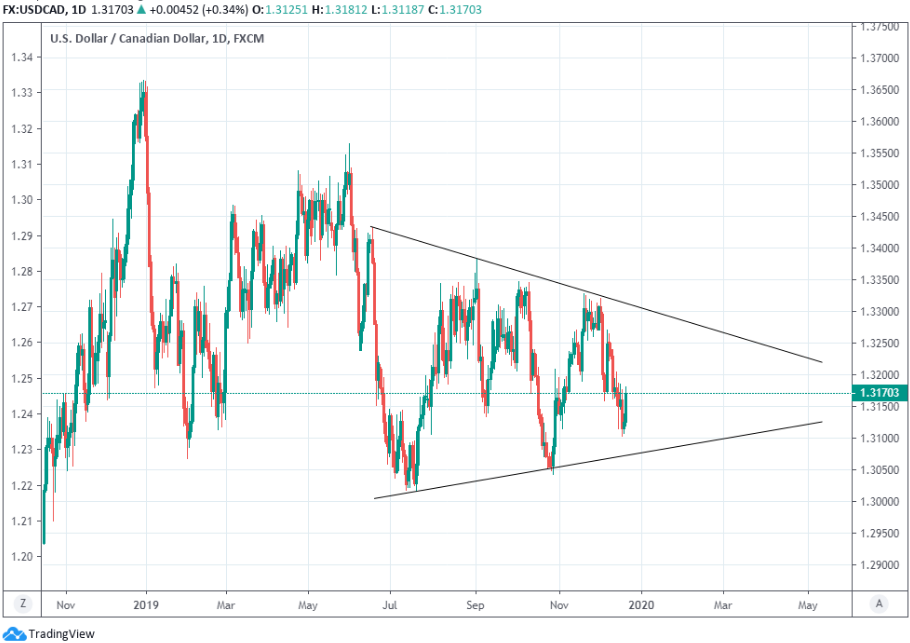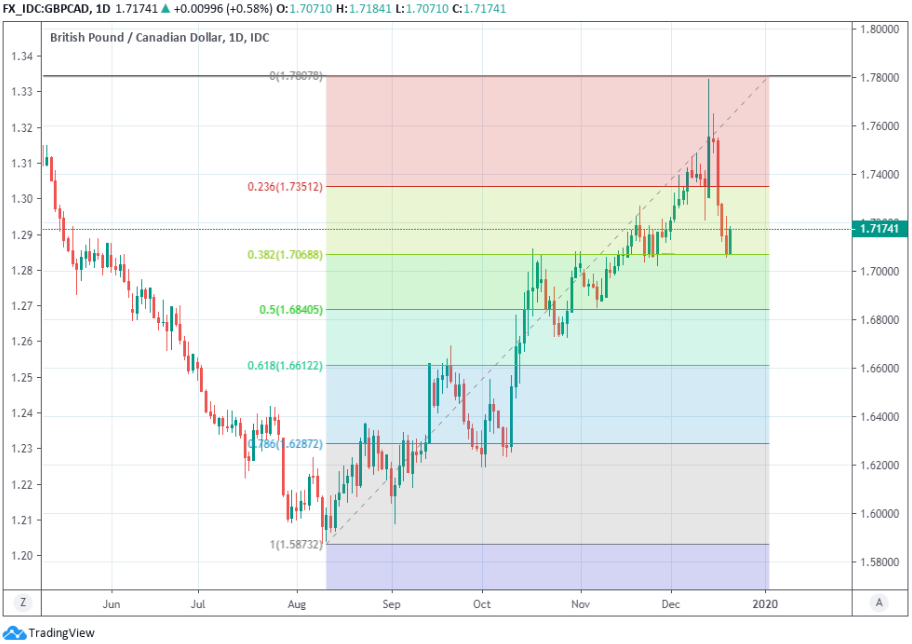Canadian Dollar Humbled in Holiday Trade as Economic Worries Linger
- Written by: James Skinner

Image © Pavel Ignatov, Adobe Stock
- CAD humbled in holiday trade by Oct economic washout.
- Retail sales slumped and the economy shrank in October.
- CA consumer wobbles as sales fall in 5 of last 6 months.
- As BoC eyes Canada's "sources of economic resilience".
- TD Securities sees BoC confidence shaken, tips rate cut.
- USD/CAD downturn runs out of steam, GBP/CAD steadies.
The Canadian Dollar has been humbled this holiday week with prior advances against the U.S. Dollar and Pound Sterling brought to a halt after weakness in the consumer sector helped drive the economy to a surprise October contraction, likely stirring unease at the Bank of Canada (BoC)
Canadian GDP fell by 0.1% in October, Statistics Canada revealed on Monday, when markets had been looking for a 0.1% gain. That means the economy will have been on its back foot from the get-go in the final quarter, after already having slowed sharply in the prior three months.
The economy saw its first contraction since February after output from the goods producing industries shrank for a second consecutive month and the services sector stalled amid weakness among retailers and wholesalers. Durable goods manufacterers saw output decline for the fourth time in five months as eight out of ten manufacturing subsectors shrank in spite of the 'phase one deal' to temporarily end the U.S-China trade war announced on October 11.
"Canada's monthly GDP print disappointed yesterday with a 0.1% contraction in October. The US dollar is carving out a small shelf near CAD1.3140. It needs to rise above CAD1.3180 to be anything important," says Marc Chandler, chief market strategist at Bannockburn Global Forex. "The US dollar is showing a firmer profile against most of the major currencies, but the Norwegian krone and Swedish krona had resisted the pull to edge higher."
This week's GDP data means Canada's economy was on the back foot from the very beginning of the final quarter, which has led some analysts to suggest it could now miss the BoC's forecast for growth into year-end. The BoC is looking for an annualised 1.3% increase in GDP but TD Securities said this week that October's figures mean Canada will be lucky to see even half that.
Above: USD/CAD rate shown at hourly intervals.
"We now track Q4 GDP growth at just 0.5%, whereas the BoC's October forecast looked for growth at 1.3%. This won't be enough of a disappointment for the Bank to move rates in January (barring some sort conflagration on the global growth outlook), but it should be enough to shake their confidence ever so slightly," says Andrew Kelvin, chief Canada strategist at TD Securities.
Just last Friday, Canadian retail sales were revealed to have slumped by 0.5% in October, when markets had been looking for a 0.2% gain. The decline was even bigger in volume terms, at -1.4%, which is what matters in the calculation of GDP. However, and adding insult to injury, Canada's statistical authority revised its earlier 0.2% estimate of September sales growth down to -0.1% which means retail sales have now contracted in five of the last six months.
The consumer was at the centre of Canada's October economic woes, which will likely come as a concern the BoC, which said only weeks ago it would be watching consumers and households closely for signs of stress in the months ahead as it deliberates on what to do with Canadian interest rates. It's also watching residential builders, a key source of recent economic gains.
"While the retail sector is a relatively small part of industry level GDP, the Canadian economy will be hard-pressed to grow at its trend pace in 2020 if the household sector is flagging. Second, there were downward revisions to September industry level GDP, which will have negative implications for Q4 GDP growth as a whole," Kelvin writes in a note to clients. "If disappointing data points continue to stack up over the next few months a spring rate cut will come more firmly into view; we continue to look for the BoC lower rates in April 2020."
Above: Pound-to-Canadian-Dollar rate shown at hourly intervals. Post-election correction appears to come to an end.
The BoC has dug its heels in of late and stood behind the view that a 1.75% cash rate is the most appropriate response to inflation that is hovering nicely around its target level as the economy putters along at recuded rates of growth from those seen in the first half of the year.
BoC policymakers have kept rates steady even as the Federal Reserve and other developed world central banks have cut their benchmarks and sought to provide policy reassurance to companies and households besieged by a still-uncertain international trade environment that's wounded the global economy.
The BoC surprised markets in December when it issued a policy decision statement in an almost hawkish tone. It said it saw signs of stabilisation in the global economy, reduced downside risks to the outlook and that it was positively surprised by the level of business investment in recent months.
Policymakers signed off with a commitment to monitor the sources of Canada's economic resilience in the months ahead and to make future cash rate decisions based upon the impact that international trade tensions are having on those various facets of the economy.
"The numbers will keep concerns alive that the domestic Canadian economic growth backdrop has lost its footing somewhat at the end of the year, particularly after an unusually bad looking November employment report," says Nathan Janzen, an economist at RBC Capital Markets. "Q4 GDP growth now looks like it's tracking firmly below the Bank of Canada's call for a 1.3% increase."

Above: USD/CAD rate at daily intervals. Consolidates within tight range amid nascent series of lower highs, higher lows.
Janzen says markets will now pay much more attention than they otherwise would have to economic figures emerging from Canada in the weeks and months ahead, with a particular focus on the next employment report after the horror show that was published by Statistics Canada earlier this month.
Earlier figures showed Canadian employment shrinking sharply in November, with the unemployment rate rising 40 basis points in a straight line to 5.9%. Local analysts and economists have long referred to Canada's labour market as a 'random number generator' but the November increase in joblessness was large even with that taken into account.
The last week's economic numbers have reinforced a recent bottom in the USD/CAD rate and helped prevent a nascent recovery in the Pound-to-Canadian-Dollar rate from coming completely undone, although technical analysts at Scotiabank have warned that Sterling will see fresh declines in the weeks ahead.
"There is still clearly some residual, longerterm momentum under the GBP so weakness may not extend immediately. However, we do think that scope for GBP gains is limited (1.72) from here. We look for corrective losses to reach the 1.66/1.68 regional potentially in the next few weeks," says Scotiabank's Juan Manuel Herrera. "The 40-week (200-day) MA may dictate whether losses hold around 1.68 (50% Fib retracement at 1.6837) or extend to the 61.8% Fib support at 1.6611. Look to fade near-term GBP gains."

Above: Pound-to-Canadian-Dollar rate shown at daily intervals. Sterling finds support at 38.2% Fibonacci retracement level.
Time to move your money? The Global Reach Best Exchange Rate Guarantee offers you competitive rates and maximises your currency transfer. Global Reach can offer great rates, tailored transfers, and market insight to help you choose the best times for you to trade. Speaking to a currency specialist helps you to capitalise on positive market shifts and make the most of your money. Find out more here.
* Advertisement





